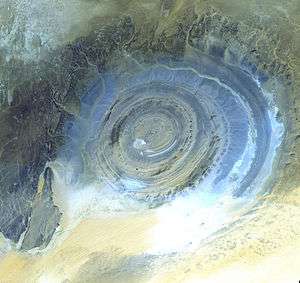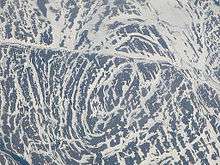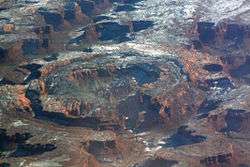Dome (geology)
A dome is a feature in structural geology consisting of symmetrical anticlines that intersect each other at their respective apices. Intact, domes are distinct, rounded, spherical-to-ellipsoidal-shaped protrusions on the Earth's surface. However, a transect parallel to Earth's surface of a dome features concentric rings of strata. Consequently, if the top of a dome has been eroded flat, the resulting structure in plan view appears as a bullseye, with the youngest rock layers at the outside, and each ring growing progressively older moving inwards. These strata would have been horizontal at the time of deposition, then later deformed by the uplift associated with dome formation.[1][2]



Formation mechanisms
There are many possible mechanisms responsible for the formation of domes, the foremost of which are post-impact uplift, refolding, and diapirism.
Post-impact uplift
A complex crater, caused by collision of a hypervelocity body with another larger than itself, is typified by the presence of a dome at the centre of the site of impact. These domes are typically large-scale (on the magnitude of tens of metres) and thought to be the result of post-impact weakening of the overlying strata and basement. Weakening is integral for the vertical uplift required to create a dome to take place, as it allows vertical displacement to happen unconstrained by the original rigidity properties of the undeformed rock.[3] This displacement is the result of the parcel of rock at the centre of the site of impact, composed of the strata and basement, re-equilibrating relative to gravity. Earlier theories attributed the dome-forming uplift to rebound; however, this would imply that the rock deforms elastically. Elastic deformation is not likely being that an impact is accompanied by extensive fracturing and partial melting of the rock that would change the mechanical properties of the rock.[4][5]
Refolding
Structural domes can be formed by horizontal stresses in a process known as refolding, which involves the superposition, or overprinting, of two- or more fold fabrics. Upright folds formed by a horizontal primary stress in one direction can be altered by another horizontal stress oriented at 90 degrees to the original stress. This results in overprinting of the twofold fabrics, similar to wave interference patterns, that results in a system of basins and domes. Where the synclines of both fabrics are superimposed, a basin is formed; however, where the anticlines of both fabrics are superimposed, a dome is formed.[6][7]
Diapirism
Diapirism involves the vertical displacement of a parcel of material through overlying strata in order to reach equilibrium within a system that has an established density gradient (see Rayleigh–Taylor instability). To reach equilibrium, parcels from a stratum composed of less-dense material will rise towards Earth's surface, creating formations that are most often expressed in cross-section as “tear drop”-shaped, where the rounded end is that closest to the surface of the overlying strata. If overlying strata are weak enough to deform as the parcel rises, a dome can form; in cases where the overlying strata are particularly devoid of resistance to applied stress, the diapir may penetrate through the strata altogether and erupt on the surface. Potential materials comprised by these less-dense strata include salt (which is highly incompressible, thus creating the structural instability that leads to diapirism when buried under deposited strata and subject to overlying stress) and partially melted migmatite (a metamorphic-texture rock frequently found in domes due to the typical involvement of heat and/or pressure with their formation).[8][9]
Examples
Impact structures
- Upheaval Dome, Utah, USA[10]
- Vredefort Dome, South Africa[11]
Refolded (structural) domes
- Observed in the Karatau fault system, Kazakhstan[12]
- North Pole Dome, Western Australia (in the Pilbara Craton)[13]
Diapiric domes
- Mabja Dome, southern Tibet[14]
- Leo Pargil Dome, Himachal Pradesh/Tibetan border[15]
Disputed origin
- Richat Structure, central Mauritania
References
- Fossen, Haakon. Structural geology. Cambridge University Press, 2010.
- Monroe, James S. and Reed Wicander. The Changing Earth: Exploring Geology and Evolution. 2nd ed. Belmont: Wadsworth Publishing Company, 1997. ISBN 0-314-09577-2
- Lana, C., Roger L. Gibson, and Wolf Uwe Reimold. "Impact tectonics in the core of the Vredefort dome, South Africa: Implications for central uplift formation in very large impact structures." Meteoritics & Planetary Science 38.7 (2003): 1093-1107.
- Lana, C., Roger L. Gibson, and Wolf Uwe Reimold. "Impact tectonics in the core of the Vredefort dome, South Africa: Implications for central uplift formation in very large impact structures." Meteoritics & Planetary Science 38.7 (2003): 1093-1107.
- Kenkmann, Thomas, et al. "Structure and formation of a central uplift: A case study at the Upheaval Dome impact crater, Utah." Large meteorite impacts III (2005): 85-115.
- Fossen, Haakon. Structural geology. Cambridge University Press, 2010.
- Grujic, Djordje, Thomas R. Walter, and Hansjörg Gärtner. "Shape and structure of (analogue models of) refolded layers." Journal of Structural Geology 24.8 (2002): 1313-1326.
- Lee, Jeffrey, Bradley Hacker, and Yu Wang. "Evolution of North Himalayan gneiss domes: structural and metamorphic studies in Mabja Dome, southern Tibet." Journal of Structural Geology 26.12 (2004): 2297–2316.
- Teyssier, Christian, and Donna L. Whitney. "Gneiss domes and orogeny." Geology 30.12 (2002): 1139–1142.
- Buchner, Elmar, and Thomas Kenkmann. "Upheaval Dome, Utah, USA: impact origin confirmed." Geology 36.3 (2008): 227-230.
- Lana, C., Roger L. Gibson, and Wolf Uwe Reimold. "Impact tectonics in the core of the Vredefort dome, South Africa: Implications for central uplift formation in very large impact structures." Meteoritics & Planetary Science 38.7 (2003): 1093-1107.
- Allen, M. B., G. I. Alsop, and V. G. Zhemchuzhnikov. "Dome and basin refolding and transpressive inversion along the Karatau fault system, southern Kazakhstan." Journal of the Geological Society 158.1 (2001): 83-95.
- Blewett, R. S., S. Shevchenko, and B. Bell. "The North Pole Dome: a non-diapiric dome in the Archaean Pilbara Craton, Western Australia." Precambrian Research 133.1 (2004): 105-120.
- Lee, Jeffrey, Bradley Hacker, and Yu Wang. "Evolution of North Himalayan gneiss domes: structural and metamorphic studies in Mabja Dome, southern Tibet." Journal of Structural Geology 26.12 (2004): 2297-2316.
- Jessup, M. J. "Stain Partitioning, Partial Melting and Exhumation off Domes along the Southern Margin of the Tibetan Plateau: Leo Pargil (India) And Lhagoi Kangri (Tibet) Domes". University of Tennessee, Knoxville. Retrieved 25 October 2015.
| Wikimedia Commons has media related to Natural domes. |